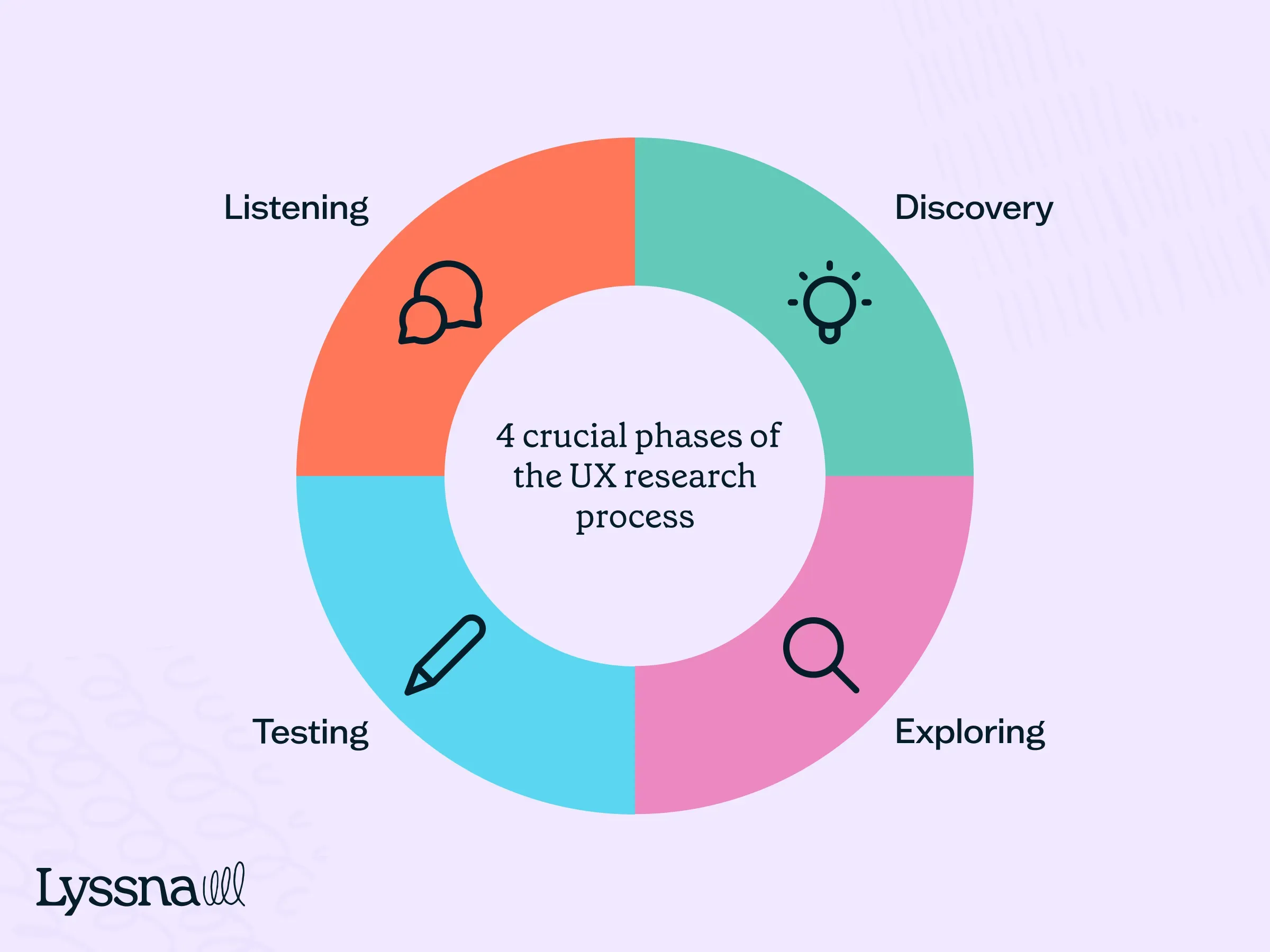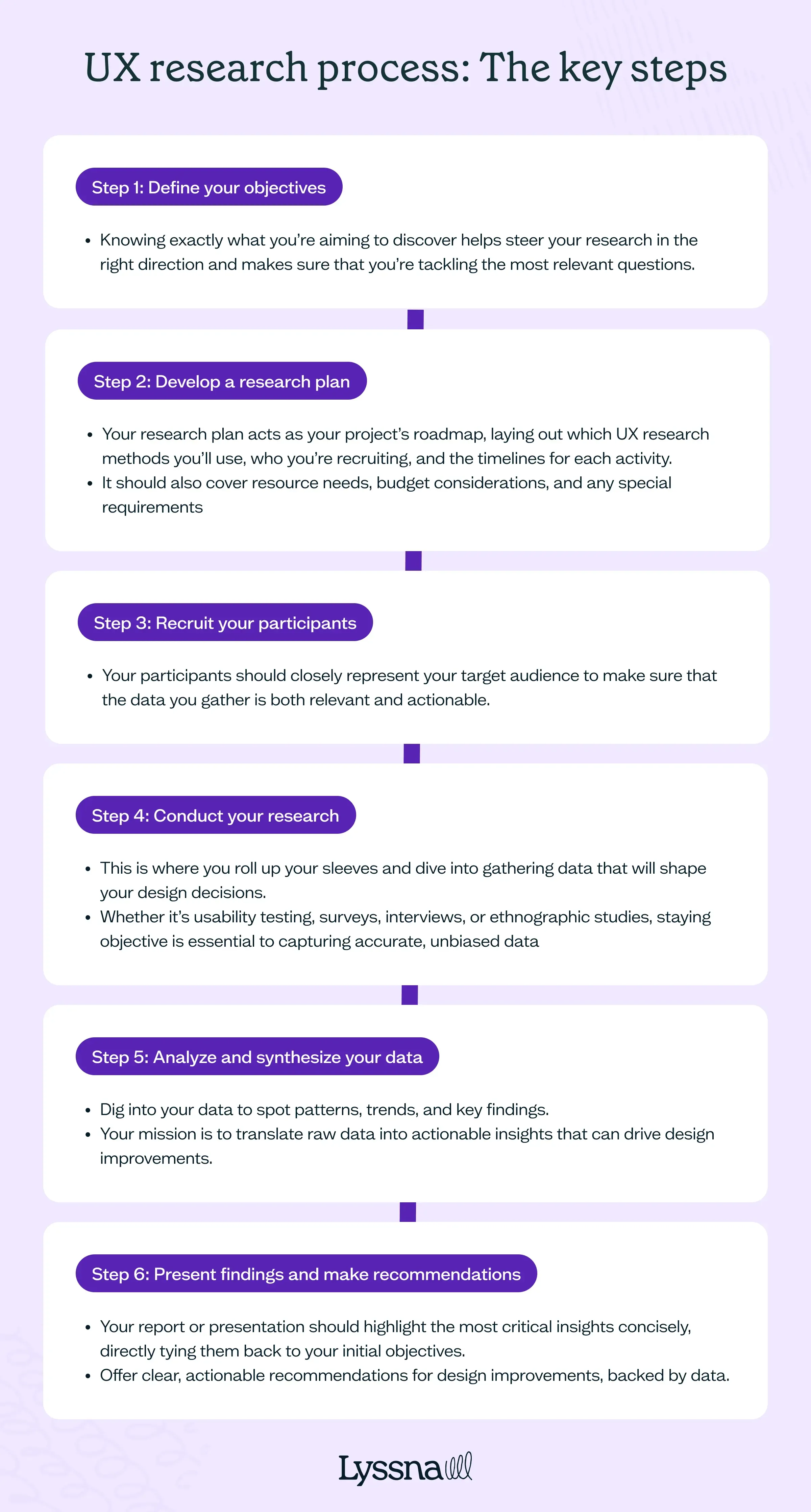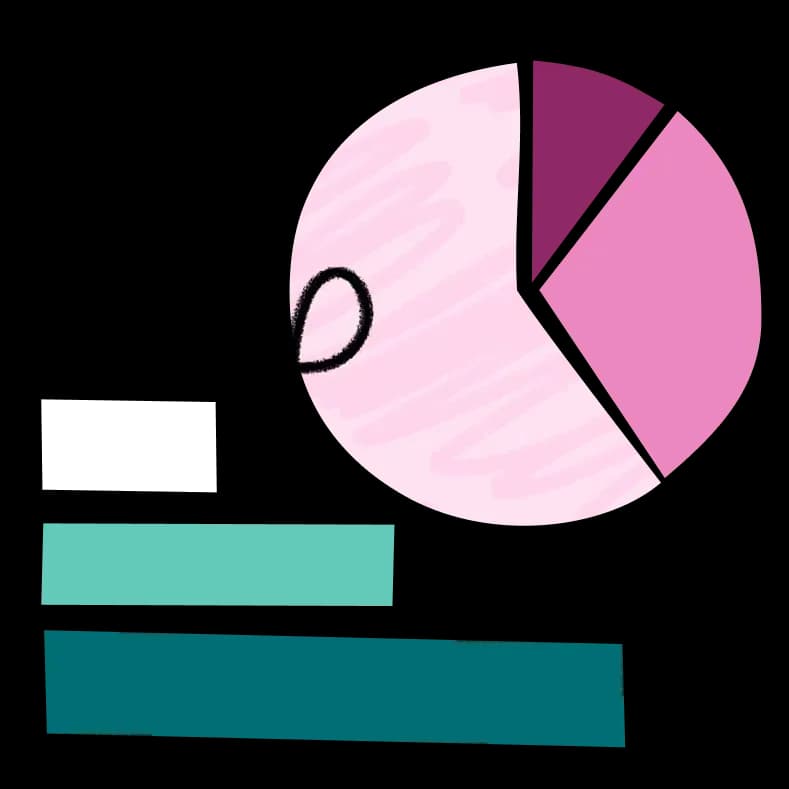UX research process
Discover the stages of the UX research process, from planning and data collection to analysis and implementation, to enhance product design and user satisfaction.
UX research guide
The UX research process: An overview
User experience (UX) research is the backbone of effective product design. It offers a structured approach to understanding users' needs, behaviors, and motivations through various observation and feedback methods.
While UX design zeroes in on crafting interfaces and experiences, UX research digs deeper into why users behave the way they do – delivering the data that drives informed design decisions.
The UX research process unfolds in multiple stages, each crucial for gathering and analyzing data. Understanding these stages also helps clarify the roles in product design vs ux design, ensuring that products aren't just functional, but are also intuitive and enjoyable for users.
The importance of establishing an effective user research process
User research lays the foundation for designing products that genuinely meet user needs, leading to higher satisfaction and loyalty. But why is it so critical to establish an effective process?

Saves time and money
The return on investment (ROI) of user research is undeniable. By understanding user behavior (and preferences) early in the development and design process, businesses can ‘fail early’– catching design flaws before they snowball into costly problems later on. Well-executed research empowers you to make informed, data-driven decisions, cutting down on guesswork and assumptions.
Helps secure stakeholder buy-in
Presenting findings backed by solid research makes it easier to gain support for design decisions. This is especially valuable in organizations with lower UX maturity, where research might still be undervalued. A structured research process provides compelling evidence, aligning teams and fostering a user-centered culture across the company.
Streamlines workflows
A clear, repeatable process enhances collaboration, ensuring that insights are consistently shared and applied. This not only improves the final quality of your product, but also speeds up the development cycle, enabling quicker iterations and more responsive design changes.
Research saves time. It saves money. It streamlines workflows. And, it cuts through the clutter to focus on what really matters – meeting user needs.
The four crucial phases of the UX research process
The UX research process is a journey that systematically uncovers user insights – guiding designers and researchers toward better product decisions. It’s about truly understanding your users – how they think, what they need, and how they interact with your product.
By breaking research down into manageable stages, teams can gather comprehensive and actionable data. The process can be divided into four key phases: discovery, exploring, testing, and listening.
Each phase uniquely contributes to understanding user behavior and product performance, moving from initial inquiry to refined improvements. Together, they form a holistic approach that mitigates design risks, fosters creativity, and drives more informed, data-driven decisions.
Let’s dive deeper into each phase and see how they work together to create an effective UX research process.

Discovery
"People ignore design that ignores people." – Frank Chimero, designer and author
The discovery phase sets the foundation for all subsequent research and design efforts.
This phase is about understanding the broader problem space and gathering key background information that shapes the direction of research. UX researchers engage in activities like stakeholder interviews, ux competitive analysis, and reviews of existing data to understand the environment users are navigating, along with clarifying business objectives and constraints.
By pinpointing the core questions that need answering, the discovery phase helps guide the choice of research methods for the next phases. It’s also crucial for formulating hypotheses to be tested later – making sure the research remains focused and aligned with user and business goals.
Exploring
The exploring phase takes the data from discovery and dives deeper into the nuances of user behavior.
This is the phase where researchers actively engage with users to gather data—often blending approaches from quantitative vs qualitative research to gain a richer understanding of users' motivations, needs, and pain points. If you're looking to expand your toolkit, these 8 types of qualitative research can help uncover deeper user insights.
Common methods used during this phase include user interviews, ethnographic studies, observational research, and surveys, a widely used type of quantitative research that helps gather measurable data at scale.
The goal here is to gather a detailed picture of the user experience, identifying patterns and pain points that can drive design decisions.
While this phase is guided by the hypotheses formed in discovery, it’s equally about uncovering new, unexpected findings. These findings often refine or expand the research focus, offering deeper clarity into user behaviors and needs.
Testing
The testing phase is all about validation – putting your ideas, designs, and assumptions from earlier phases to the test. At this stage, the focus shifts to evaluating how well your design solutions address identified user needs. Methods like usability testing, A/B testing, and prototype testing help gather feedback on specific design elements.
This phase is critical as it helps you validate your design hypotheses. Testing highlights usability issues, reveals whether your solutions resonate with users, and identifies areas needing further iteration. Iteration is key, with feedback from testing driving continuous improvements before you release the product or feature.
Listening
The listening phase goes beyond the initial product launch, emphasizing continuous feedback and iteration. UX research doesn’t end once the product goes live – researchers keep gathering user feedback and monitoring product performance in real-world settings. Post-launch surveys, user interviews, analytics monitoring, and ongoing usability tests all help track how users interact with the product over time.
This phase creates a feedback loop, where the data you collect inform future discovery phases – enabling ongoing product improvement. By staying in tune with user behavior, you can adapt to changing user expectations and market conditions, maintaining a competitive edge and enhancing long-term user satisfaction.
By following these four crucial phases, you build a comprehensive UX research process that not only meets current user needs but also adapts to future changes.
Tired of research headaches? Let's fix that!
Feeling overwhelmed by the research process? Lyssna's got your back. Our all-in-one platform makes recruiting participants, running studies, and analyzing data a breeze. Why not take it for a spin?
UX research process: The key steps
Navigating the UX research process can feel daunting, but with the right approach, each step builds on the last, turning raw data into powerful insights.
Below, we break down the essential steps to make sure your research is thorough, focused, and impactful – from defining objectives to making informed recommendations that drive design decisions.

Step 1: Define your objectives
Start by setting clear objectives – knowing exactly what you’re aiming to discover helps steer your research in the right direction and makes sure that you’re tackling the most relevant questions.
Are you looking to uncover user behavior patterns, test a new feature, or pinpoint pain points in the customer journey? Defining these goals up front sharpens your focus and guides your choice of UX research methods and tools.
This phase isn’t just about the research team – it’s about collaboration. Engage with stakeholders to align on goals, making sure that your objectives also meet business needs and project constraints.
Step 2: Develop a research plan
With your objectives decided, it’s time to chart your course with a detailed research plan.
This plan acts as your project’s roadmap, laying out which UX research methods you’ll use, who your participants will be, and the timelines for each activity. It should also cover resource needs, budget considerations, and any special requirements – like external participant recruitment or specific software tools.
Remember, flexibility is your friend here. Research can take unexpected turns, and your plan should be sturdy enough to guide you but flexible enough to adapt as new findings or challenges arise. A delicate balancing act, at times, admittedly!
Step 3: Recruit your participants
The right participants are the cornerstone of reliable research. Your participants should closely represent your target audience to make sure that the data you gather is both relevant and actionable. Depending on your research focus, this might mean seeking participants with specific demographics or characteristics. For instance, if you’re exploring a mobile banking app for millennials, make sure your participants reflect that user group.
Diversity in your participant pool is crucial – it helps avoid biases and enriches your data with a broad range of perspectives.
Step 4: Conduct your research
Now comes the heart of the process: conducting the research. This is where you roll up your sleeves and dive into gathering data that will shape your design decisions. Whether it’s usability testing, surveys, interviews, or ethnographic studies, staying objective is essential to capturing accurate, unbiased data.
When running usability tests, make sure tasks are grounded in real-world scenarios your users would actually face. If conducting interviews, lean into open-ended questions that encourage participants to share their experiences in their own words. Your goal is to capture feedback that truly reflects how users interact with your product.
Step 5: Analyze and synthesize your data
With data in hand, now it’s time to make sense of it all!
Analyzing and synthesizing involves digging into your data to spot patterns, trends, and key findings. Quantitative data often involves statistical analysis, while qualitative data requires a deeper dive into categorizing responses and identifying recurring themes.
Your mission is to translate raw data into actionable insights that can drive design improvements. Visual tools like personas, journey maps, or a well-crafted ux research report can make these insights more accessible and compelling for stakeholders, turning complex data into clear, impactful guidance for your product team.
Step 6: Present findings and make recommendations
The final step is where it all comes together – presenting your findings to stakeholders and recommending the next steps. Your report or presentation should highlight the most critical insights concisely, directly tying them back to your initial objectives.
Offer clear, actionable recommendations for design improvements, backed by data. Whether you’re creating visual presentations, detailed reports, or leading workshops, the goal is to make sure your findings resonate with your team and drive meaningful change.
By following these steps, you build a strong UX research process that takes your team from initial exploration to actionable design insights – transforming raw user feedback into a strategic asset that fuels better product experiences.
Ready to level up your UX research game?
Don't let complex tools slow you down. Lyssna's user-friendly platform has everything you need to nail your research process – from quick surveys to in-depth user interviews.
Simplify the UX research process with Lyssna
Conducting UX research can be complex, especially when managing tight resources and deadlines. Lyssna simplifies this process by offering a streamlined, all-in-one platform designed to make UX research more efficient and data-driven.
User-friendly experience
Lyssna’s intuitive interface is accessible for both experienced researchers and beginners. It allows you to easily set up your studies, recruit participants, and gather data – whether through moderated usability testing or unmoderated ux study – so you can focus on understanding your users, not on navigating the platform.
Comprehensive research tools
Lyssna covers every aspect of the UX research process with a variety of tools such as card sorting, tree testing, and first click testing. We also accommodate static images, prototypes, and video content, ensuring your research adapts to different project needs.
Fast and targeted recruitment
Recruiting participants can be time-consuming, but Lyssna reduces that burden. With a panel of over 690,000 participants across diverse demographics, you can recruit the right audience quickly, often in under 30 minutes, ensuring your research is relevant and actionable.
Affordable plans
Lyssna’s free plan includes unlimited tests, surveys, and interviews, with affordable paid options for more advanced features. This flexibility allows you to choose a plan that fits your budget without sacrificing quality.
Continuous improvement
Committed to evolving with user needs, Lyssna regularly updates its platform based on feedback. We also offer strong customer support to make sure you get the very most out of the tools.
Lyssna helps you streamline your research, gain deeper insights, and create products that resonate with users – whether you’re at a startup or a larger enterprise.


